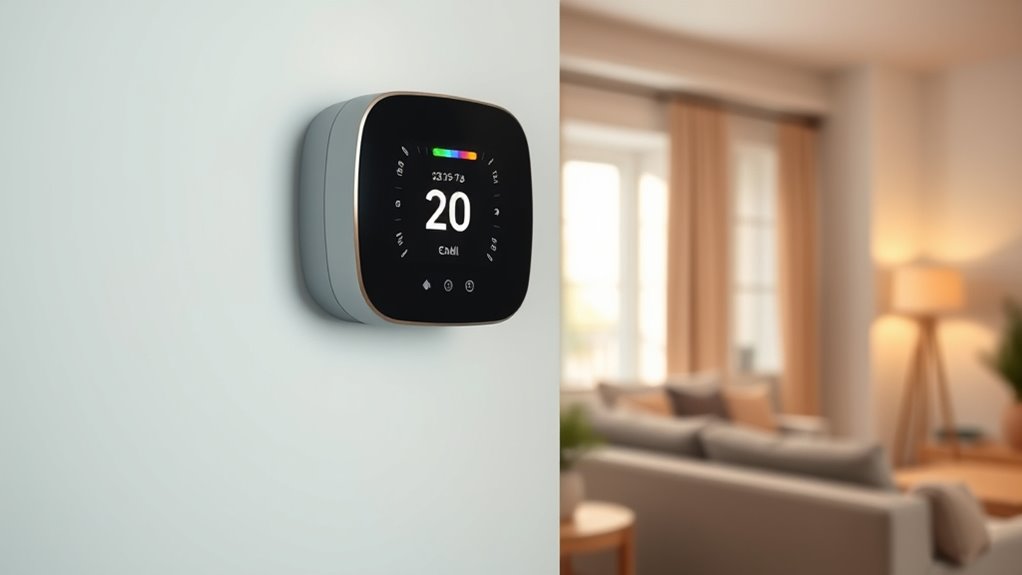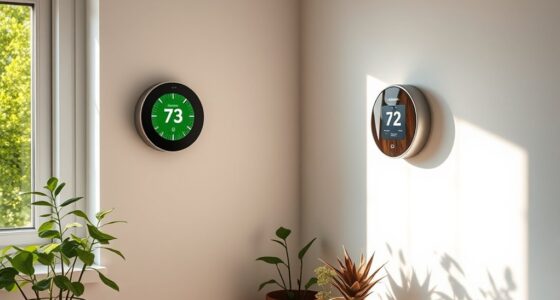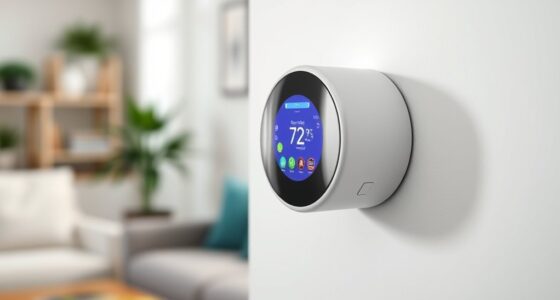To maximize energy savings through temperature scheduling, set your thermostat to adjust based on your daily routines and occupancy. Use smart thermostats to automatically lower temperatures when you’re away or asleep and raise them when you’re home and active. Incorporate occupancy sensors to detect when rooms are unoccupied and adjust accordingly. For even better results, schedule different settings for weekdays and weekends, ensuring your system runs efficiently without waste. Keep exploring for more tips to enhance your savings further.
Key Takeaways
- Use smart thermostats to create customized schedules that align with your daily routines and occupancy patterns.
- Implement occupancy sensors to automatically adjust temperatures when rooms are unoccupied.
- Set different temperature schedules for weekdays and weekends based on presence and activity levels.
- Lower the thermostat during sleep hours and work hours to reduce energy consumption without sacrificing comfort.
- Regularly maintain HVAC systems and filters to ensure optimal efficiency alongside strategic temperature scheduling.

Implementing temperature scheduling can substantially reduce your energy bills by optimizing heating and cooling times. By setting your system to operate only when needed, you avoid wasting energy during unnecessary periods, leading to significant savings over time. Modern smart thermostats make this process effortless, allowing you to program different temperatures for various times of the day. These devices learn your schedule and preferences, automatically adjusting settings to maximize efficiency. With smart thermostats, you can also control your home’s temperature remotely via smartphone apps, giving you the flexibility to make changes on the go and prevent energy waste when you’re away.
Smart thermostats optimize energy use by scheduling heating and cooling efficiently.
Occupancy sensors play a pivotal role in enhancing your temperature scheduling strategy. These sensors detect when rooms are occupied and can trigger your heating or cooling systems accordingly. When a room is unoccupied, the sensors signal the thermostat to lower or raise the temperature, depending on whether you’re heating or cooling. This targeted approach prevents energy from being used in empty spaces, making your system more responsive and efficient. Integrating occupancy sensors with your smart thermostat creates a seamless system that adapts to your daily routines without requiring constant manual adjustments.
To maximize savings, you should also consider setting different schedules for weekdays and weekends, aligning your system with your typical presence at home. For example, during work hours, you can set the temperature to be less energy-intensive, then revert to a comfortable setting when you return. At night, lowering the thermostat slightly can save energy without sacrificing comfort. Smart thermostats often come with pre-programmed templates or the ability to customize schedules easily, so you don’t have to keep manually changing settings. This automation ensures your system operates efficiently without constant oversight.
In addition to scheduling, it’s essential to keep your HVAC system well-maintained. Regularly replacing filters and scheduling professional tune-ups ensure your system runs smoothly and consumes less energy. Proper maintenance can also help prevent issues caused by Mazda Tuning components that might be indirectly related to HVAC system performance. Combining this maintenance with a strategic temperature schedule optimized by smart thermostats and occupancy sensors can drastically cut your energy consumption. Over time, these practices not only lower your utility bills but also extend the lifespan of your HVAC equipment, saving you money in the long run.
Frequently Asked Questions
How Does Temperature Scheduling Affect Indoor Air Quality?
Temperature scheduling can impact your indoor air quality by improving ventilation control, which helps reduce pollutants and maintain fresh air. When you set specific temperatures for different times, it encourages your HVAC system to operate efficiently, ensuring proper air circulation. This balance prevents stale air buildup and minimizes humidity issues, creating a healthier indoor environment. Proper scheduling supports consistent air quality, making your space more comfortable and safe without sacrificing energy efficiency.
Can Temperature Scheduling Improve HVAC System Lifespan?
Think of your HVAC system as a well-tuned orchestra; proper temperature scheduling is the conductor. By setting a smart thermostat to optimize temperatures, you reduce strain on components, preventing wear and tear. This careful orchestration helps extend your system’s lifespan and maintains user comfort. Regularly adjusting your schedule guarantees your HVAC runs smoothly, avoiding unnecessary breakdowns and costly repairs, all while keeping your home cozy.
What Are the Best Settings for Weekends and Holidays?
For weekends and holidays, set your thermostat to a higher temperature in summer or a lower one in winter to save energy without sacrificing occupant comfort. Guarantee your settings are compatible with your HVAC system to prevent issues. Use programmable thermostats to automate these schedules, maintaining system efficiency and comfort. Customize these settings based on your routine, and check that they align with your system’s capabilities for ideal performance.
Is Temperature Scheduling Suitable for All Climate Zones?
Temperature scheduling can be suitable for most climate zones if you consider climate adaptability and zoning strategies. You’ll need to tailor your schedule based on local weather patterns and seasonal changes, adjusting settings accordingly. By implementing zoning strategies, you can optimize energy savings across different areas of your home. While it’s effective in many climate zones, always evaluate your specific environment to verify your temperature schedule maximizes comfort and efficiency.
How Quickly Can I See Energy Savings After Adjustments?
You can see energy savings within days of adjusting your smart thermostat with energy monitoring. The moment you set a new schedule, your system begins optimizing comfort and efficiency. Keep an eye on your energy consumption; early results often surprise you. The real impact unfolds quickly, rewarding your effort with lower bills and smarter control—making every degree count, right from the start.
Conclusion
So, you’ve learned that a simple temperature schedule can save energy—and money—yet many ignore it, thinking comfort is worth extra costs. Ironically, by just tweaking your thermostat, you could enjoy cozy savings without sacrificing comfort. Instead of wasting energy on constant heating or cooling, you’re actually giving your wallet a break while still feeling just right. Who knew that a small change could make such a big difference, all while making your home more efficient?








